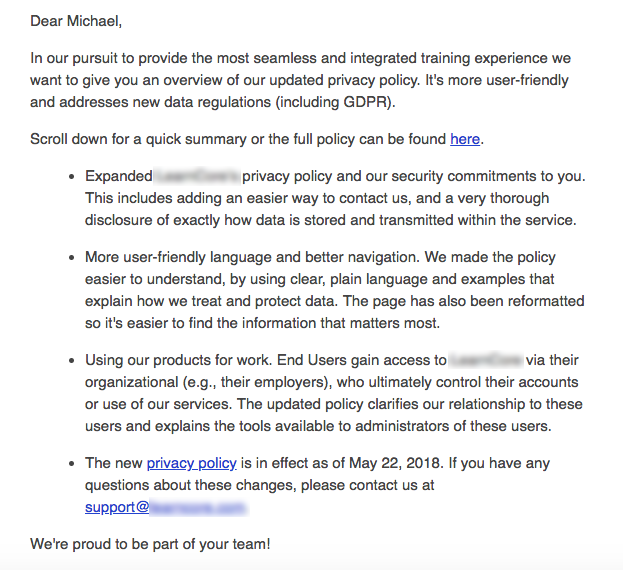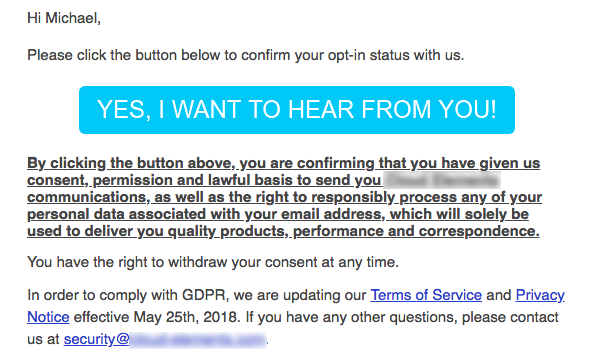Unless you’ve been vacationing under a rock for the past several months, the new GDPR regulations have been largely inescapable. The deluge of emails from nearly every vendor announcing compliance initiatives and updated privacy policies has spawned a number of humorous memes, and a not insignificant amount of customer irritation.
Now that the dust has settled and GDPR is officially in place, there are a number of questions that remain about sending emails. The new regulations certainly don’t ban marketing or customer emails outright, but they do add a degree of risk – especially when it’s not 100% clear what qualifies as consent.
Do You Have Permission to Email?
This is the critical question. GDPR regulations state that in order to receive email from a company, individuals must affirmatively opt in. But what is considered an opt-in? These two GDPR emails from different software companies show that the definition is far from conclusive.
Both of these emails were sent to me from SaaS companies (names redacted) ahead of the May 25th deadline as part of GDPR compliance initiatives, yet the content and tone are completely different. One company sent a simple notice about policy changes, the other a rather desperate plea for opt-in. The second company clearly believes they need to re-secure affirmative opt-in before sending future emails. The first company does not. Who is right? (It’s worth noting I have a similar relationship with both companies)
The reality is that it’s hard to say. Until the GDPR regulations are fully implemented, and the first few cases are adjudicated we won’t know for certain how precisely “opt-in” requirements will be defined.
The Good News is that Email is Kind of Terrible Anyway
The uncertainty around email communication in the era of GDPR might actually be a good thing. We’re all reliant on and at the same time inundated by email communication. As a result, most of the things that make their way into our inboxes are largely ignored. Even “friendly” emails, where the customer has a relationship with the company, struggle to attain a 10% response rate.
GDPR gives companies an opportunity to reset some of their communication strategies, and think through when and where email outreach makes sense… and when it doesn’t. By leveraging other communication channels, companies can ensure higher uptake of important messages, and we can all reduce a bit of inbox bloat.
Your Customers Have Definitely Opted Into Your Product
One important and powerful channel that isn’t impacted by GDPR uncertainties is your product itself. Simply by the act of using it, your customers and prospects have affirmatively opted into receiving information on the screen. This makes it an ideal channel for customer communication.
By virtue of hitting people when they’re actually thinking about your product, your message is much more likely to be read and responded to. Our customers who move messaging from email into the product have seen anywhere from a 2x to 10x increase in response rates.
As it turns out the product is also a great channel for GDPR communication. After using Pendo to move user onboarding and education content into the product, the team at Zmags realized that they could do the same with GDPR-related announcements. Eschewing email, they pushed notifications of privacy policy and terms and conditions changes to customers in the product, requiring they respond. This approach ensured that users saw the updates, and allowed Zmags to record views and acceptance of the new policies.
The New Era of Email
GDPR won’t kill email communication. It remains an important communication channel, and we at Pendo certainly continue to use it to reach out to customers and prospects. What the uncertainty around GDPR will do is cause companies to be more thoughtful about the emails they do send. GDPR offers EU citizens who feel their personal data is being misused a powerful recourse to go after companies (several large lawsuits were filed immediately after the new regulations went into effect).
Using the product itself as a communication channel frees companies from uncertainty over opt-in, and as a bonus, improves engagement and responses to messages. If you’re concerned about effectively reaching your customers in the era of GDPR, in-app communication is an effective tool to explore.






